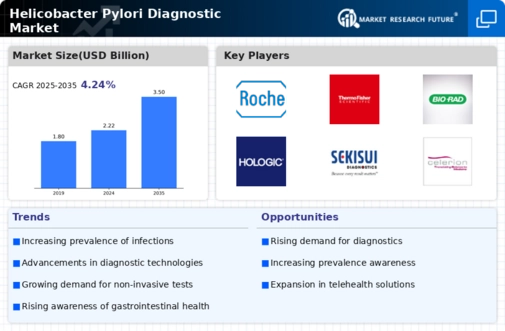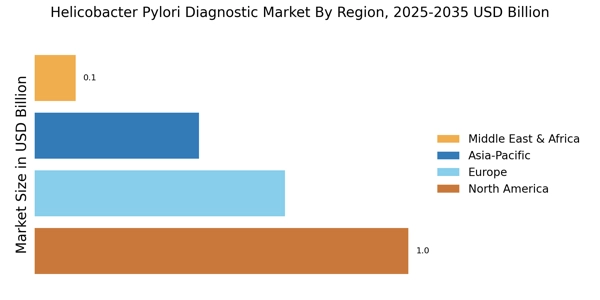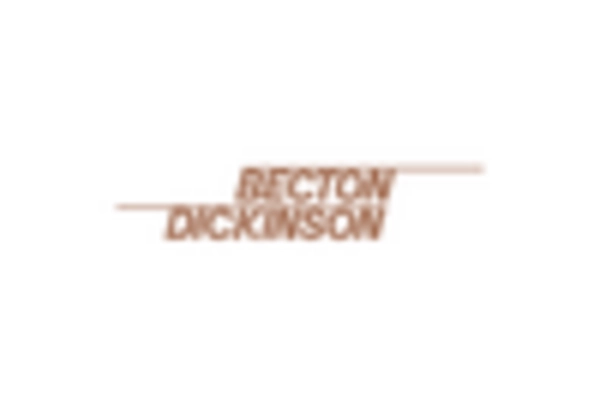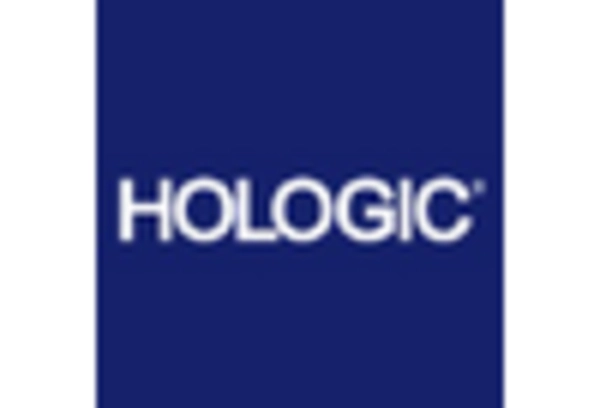Increase in Healthcare Expenditure
The rise in healthcare expenditure across various regions is contributing to the growth of the Helicobacter Pylori Diagnostic Market. As governments and private sectors allocate more resources to healthcare, there is a corresponding increase in funding for diagnostic services. This trend is particularly evident in developing regions, where investments in healthcare infrastructure are expanding access to diagnostic testing. Enhanced funding allows for the procurement of advanced diagnostic technologies and the implementation of screening programs for H. Pylori infections. Consequently, this increase in healthcare expenditure is likely to bolster the market, as more individuals gain access to essential diagnostic services.
Advancements in Diagnostic Technologies
Technological innovations are significantly influencing the Helicobacter Pylori Diagnostic Market. The introduction of advanced diagnostic tools, such as molecular assays and rapid antigen tests, has enhanced the accuracy and speed of H. Pylori detection. For instance, the development of non-invasive breath tests has gained traction due to their ease of use and reliability. These advancements not only improve patient outcomes but also streamline the diagnostic process, making it more efficient for healthcare providers. As these technologies continue to evolve, they are likely to attract investment and drive market growth, as stakeholders seek to adopt the latest solutions for H. Pylori detection.
Rising Awareness of Gastrointestinal Health
There is an increasing awareness of gastrointestinal health among the general population, which is propelling the Helicobacter Pylori Diagnostic Market. Educational campaigns and health initiatives are emphasizing the importance of early detection and treatment of H. Pylori infections. This heightened awareness is leading to more individuals seeking diagnostic testing, thereby increasing the demand for H. Pylori diagnostic solutions. Furthermore, as healthcare systems prioritize preventive measures, the market is expected to witness a surge in the adoption of screening programs aimed at identifying H. Pylori infections in at-risk populations. This trend is likely to foster a more proactive approach to gastrointestinal health.
Regulatory Support for Diagnostic Innovations
Regulatory bodies are increasingly supporting the development and approval of innovative diagnostic solutions within the Helicobacter Pylori Diagnostic Market. Streamlined approval processes and guidelines for new diagnostic tests are encouraging manufacturers to invest in research and development. This regulatory support is crucial for bringing novel diagnostic tools to market, which can address the growing need for effective H. Pylori detection methods. As a result, the market is likely to experience an influx of new products that enhance diagnostic capabilities, ultimately benefiting healthcare providers and patients alike. The favorable regulatory environment may also stimulate competition among manufacturers, further driving innovation.
Growing Prevalence of Helicobacter Pylori Infections
The rising incidence of Helicobacter Pylori infections is a primary driver for the Helicobacter Pylori Diagnostic Market. Studies indicate that nearly half of the world's population is infected with this bacterium, which is linked to various gastrointestinal disorders, including peptic ulcers and gastric cancer. As awareness of these health risks increases, the demand for effective diagnostic solutions is likely to surge. This trend is further supported by the growing number of healthcare initiatives aimed at screening and treating H. Pylori infections. Consequently, the market for diagnostic tools is expected to expand, as healthcare providers seek reliable methods to identify and manage these infections.


















Leave a Comment